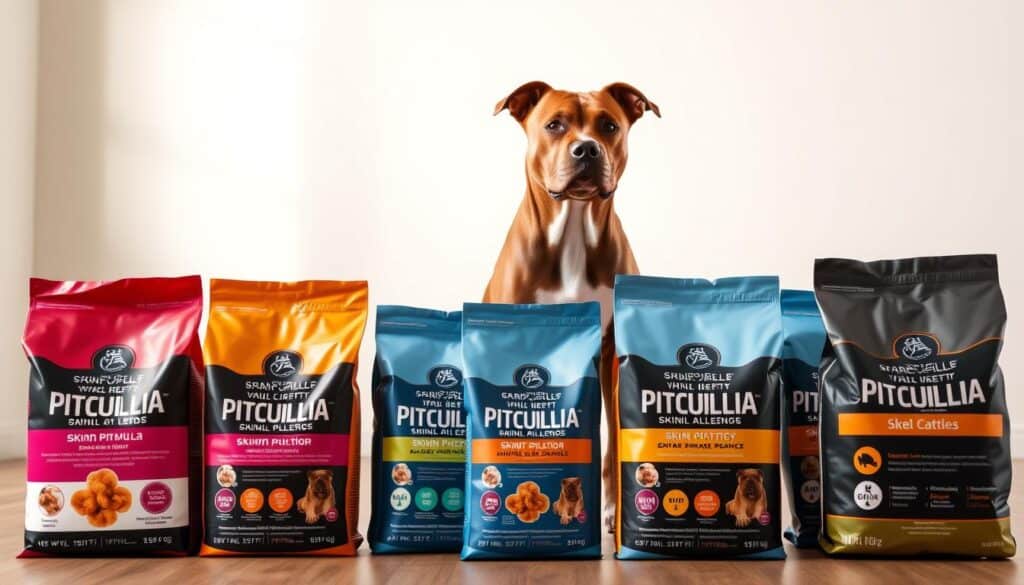Many dogs suffer from skin allergies, causing them discomfort and health issues. It’s important for owners to find the best dry dog food for these allergies. The right dog food can help ease symptoms and improve their health.
Hypoallergenic dog food is a great option for dogs with allergies. It’s made to reduce allergy triggers and provide the nutrients they need. Knowing what to look for in dog food can help pets with skin problems a lot.
Key Takeaways
- Skin allergies are common in dogs and can cause significant discomfort.
- Choosing the right dog food can alleviate allergy symptoms.
- Hypoallergenic dog food is specially made for dogs with sensitivities.
- A balanced diet is key to a pet’s overall health.
- Talking to a vet can help pick the right food.
Understanding Skin Allergies in Dogs
Skin allergies can be a big problem for dogs and their owners. Many things can cause skin allergies in dogs. Common culprits include pollen, dust mites, certain foods, and chemicals.
Knowing the different types of dog skin allergies is key to treating them. This knowledge helps manage symptoms better.
Environmental allergies can make a dog’s skin itchy and inflamed. Flea bites can also cause severe reactions. Knowing what triggers these allergies helps owners make better choices for their dog’s diet and environment.
Changing a dog’s diet can greatly reduce allergic reactions. This can improve their overall quality of life.
Symptoms of Skin Allergies to Watch For
Dog owners need to keep a close eye on their pets’ health. It’s important to spot dog skin allergy symptoms early. Look out for signs like persistent itching, redness, and hot spots.
Swelling and thinning fur are also warning signs. These symptoms can affect your dog’s comfort and happiness.
But allergies can also cause stomach problems. So, watch for changes in your dog’s overall health. Catching these symptoms early helps your dog feel better and live better.
Importance of Choosing the Right Dog Food
Choosing the right dog food is key to keeping a dog’s skin healthy and happy. Many dog foods have allergens that can make skin problems worse. Knowing what your dog needs can help you pick the best food.
Good proteins and carbs are important for a balanced diet. They help reduce skin irritation. This makes your dog feel better.
Essential fatty acids are also important for skin health. They keep the skin hydrated and less likely to react to allergens. Choosing foods with fewer ingredients can help avoid allergic reactions.
Hypoallergenic foods are great for dogs with sensitive skin. They have fewer common allergens, making them safer for your pet.
Best Dry Dog Food for Skin Allergies
Finding the right dry dog food is key for pet owners wanting to help their dogs. The right food can greatly improve skin health. This helps reduce discomfort and irritation from allergies. Knowing what ingredients are best is important when choosing.
Top Ingredients to Look For
High-quality proteins are essential for dog food for skin allergies. Turkey, lamb, and fish are great because they reduce inflammation. Also, grains or grain-free options are good for health.
Sweet potatoes, peas, and pumpkin are great for the gut and immune system. These ingredients help with skin health and overall energy.
Avoiding Common Allergens
Knowing what to avoid is key for managing skin allergies. Beef, dairy, soy, and wheat can cause problems. Choosing the right food means avoiding these allergens.
By doing this, owners can make their dogs’ lives more comfortable. It helps prevent flare-ups and keeps them happy and healthy.
Best Dry Dog Food for Skin Allergies and Yeast Infections
Skin allergies and yeast infections in dogs often go hand in hand. They can make a dog’s life very tough. Yeast infections happen when the skin’s natural balance is off, making things worse.
Changing what a dog eats can really help. The right dry dog food can make a big difference. It can help a dog’s skin get better and feel more comfortable.
Impact of Yeast Infections on Skin Health
Yeast infections can make dogs itch a lot and feel really uncomfortable. Dogs with food allergies might have too much yeast on their skin. This makes their skin problems even worse.
It’s important to find the right food for dogs with yeast infections. The right ingredients can help their skin get better. This makes their skin healthier.
Recommended Brands for Yeast-Infected Dogs
Choosing the right brand is key. Brands like Royal Canin make special food for dogs with skin allergies and yeast infections. Their food has the right nutrients for a dog’s immune system and skin.
Wellness is another great choice. They offer grain-free recipes that are easy on a dog’s stomach. This helps avoid allergies. The best food can really improve a dog’s life.
Best Dry Dog Food for Pitbulls with Skin Allergies

Pitbulls have special needs, like those with skin allergies. They need high-quality food that supports their health. Look for dog food with premium proteins, healthy fats, and vitamins and minerals.
Nutritional Needs of Pitbulls
Pitbulls need a balanced diet with protein, carbs, and fats. Protein from meat like chicken or fish helps build muscles. Carbs from sweet potatoes or brown rice give energy. Healthy fats, like omega fatty acids, keep their skin and coat healthy.
Special Formulations for Pitbulls
Choosing the right dog food is key for pitbulls with skin allergies. Brands like Blue Buffalo and Merrick have special recipes. These recipes are made with limited ingredients or are grain-free to reduce allergens.
Best Dry Dog Food for Dogs with Skin Allergies
Finding the right dry dog food for dogs with skin allergies can be tough. Pet owners look for food that heals and gives balanced nutrition. Reviews and testimonials help guide them to the best choices.
Many brands offer food for allergy-prone dogs. They use high-quality ingredients that avoid common allergens.
Top Product Reviews
Hill’s Science Diet and Blue Buffalo are among the top picks. Hill’s Science Diet Sensitive Stomach & Skin formula has prebiotics and Omega fatty acids. It helps keep the coat and skin healthy.
Customers love how digestible it is, which is great for sensitive dogs.
Blue Buffalo’s Basics Limited Ingredient Diet is also popular. It has single animal protein sources and avoids grains and dairy. People say their dogs’ skin gets better and they itch less after switching to this food.
Success Stories from Dog Owners
Many dog owners share stories of their pets’ improvements. One owner saw her dog scratch less and have less redness in just two weeks with Natural Balance L.I.D. Sweet Potato & Fish formula. Others say their dogs have more energy and feel better overall after trying the best dry dog food for skin allergies.
Homemade Alternatives to Commercial Dog Food
Homemade dog food can help manage skin allergies in pets. It lets owners create meals that fit their dog’s needs. They use healthy ingredients and avoid common allergens.
Recipes often include sweet potatoes, carrots, and lean meats like turkey or chicken. These provide important nutrients without causing allergies.
Making homemade dog food requires careful preparation. Cook ingredients well and avoid harmful additives like salt or sugar. Store meals in airtight containers in the fridge to keep them fresh.
This approach improves skin health and overall well-being. It’s a great way to nourish your dog.
When switching to homemade food, start by mixing it with commercial dog food. This helps your dog’s digestive system adjust slowly. This gradual transition ensures a smooth change to a customized diet that addresses your dog’s health issues.
How to Transition Your Dog to New Food

Changing your dog’s food needs to be done slowly and carefully. Sudden changes can upset their stomach. So, it’s important to have a step-by-step plan for the transition.
Start by mixing a little of the new food with their current kibble. Begin with a 25% new food to 75% old food ratio.
Over a week to ten days, slowly add more new food and less old food. By day five, aim for a 50% new to 50% old ratio. This gradual change helps their stomach adjust.
When switching dog food, watch for any signs of discomfort or allergies. Look for changes in their appetite, stool, or behavior. Keeping a close eye helps ensure a smooth transition and keeps your pet healthy and happy.
Monitoring Your Dog’s Response to New Food
Switching to a new diet can be a big step in helping dogs with skin allergies. It’s key to watch how your dog reacts to the new food. This helps you see if they have any food allergies.
Watch for good signs like a better coat. This means the new food is working well for your dog. Also, less itching is a good sign that allergies might be better.
But, watch out for bad signs like upset stomachs. This can show up as diarrhea or vomiting. Keeping track of these changes helps you make the right diet choices for your dog.
Some dogs adjust easily, but others might need more time or a different diet. By watching closely, you can help your dog manage their allergies better. This ensures they get the best diet for their health.
Incorporating Supplements for Skin Health
Adding supplements to a dog’s diet can greatly improve their skin health. A balanced diet, along with the right supplements, can make a big difference. Omega fatty acids and probiotics are key for a healthy coat and skin.
Omega Fatty Acids
Omega-3 and omega-6 fatty acids are vital for skin health. They reduce inflammation, stop itching, and strengthen the skin. These nutrients are found in fish oil supplements.
Dogs with enough omega fatty acids have shinier coats and healthier skin. Knowing the importance of omega fatty acids helps choose better food for dogs with allergies.
Probiotics and Their Benefits
Probiotics help keep the gut healthy and can lessen allergic reactions. They support the immune system, making dogs less likely to have skin problems. This shows how important gut health is for skin.
Adding probiotics to a dog’s diet can work well with omega fatty acids. This combination helps tackle skin allergies effectively. With the right supplements, dogs can live happier, healthier lives.
Additional Tips for Managing Skin Allergies in Dogs
Managing skin allergies in dogs needs a mix of strategies. It’s not just about the food they eat. Regular grooming is key to remove allergens and dirt from their coat. This can help lessen skin irritation.
A clean home is also important. It helps keep your dog away from things that might trigger allergies.
Knowing what causes allergies in your dog’s season can help too. Watch when your dog gets worse and take steps to protect them then. Stress can make allergies worse, so finding ways to calm your dog is important. This could be a quiet spot, gentle play, or natural supplements to help them relax.
Using these methods can make your dog’s life better. It’s part of a bigger plan to fight skin allergies.
Selecting the Best Vet for Nutritional Advice
Managing a dog’s skin allergies starts with the right vet advice on dog nutrition. It’s important to find a vet who specializes in nutrition. They have the knowledge to create a diet plan that boosts your dog’s skin health.
When picking a vet for dogs with allergies, look at their credentials and experience. Ask for recommendations from other pet owners or local pet groups. Also, check if the clinic stays up-to-date with the latest in pet care.
Working together with your vet is key to managing your dog’s allergies. Good communication helps make changes to the diet as needed. With the right vet, you can help your dog live a healthier, happier life.




